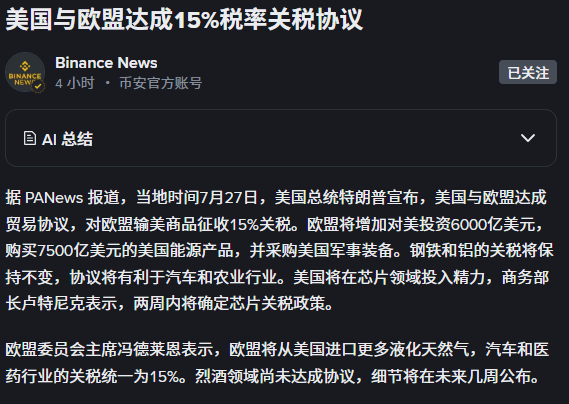Last night, Trump and European Commission President Von der Leyen jointly dropped a 'nuclear-level' agreement: the EU splurges 750 billion dollars to purchase American energy, 600 billion dollars for direct investment in the U.S., and will procure hundreds of billions in military equipment to show loyalty! In exchange, several EU countries will open a zero-tariff market to the U.S., but car trade will face a precise 'scythe' — a uniform 15% tariff, and the pharmaceutical sector will be completely excluded.

Interestingly, within 24 hours before the agreement was announced, Bitcoin suddenly surged violently by 2%, breaking through 118,000 dollars, while Ethereum also broke through the 3,700 dollar mark, causing 77,000 global short-sellers to suffer devastating liquidations! This is no coincidence — Fundstrat's chief analyst Thomas Lee interpreted this urgently: 'The agreement eliminated the biggest tail risk, and capital is shifting from safe-haven assets to high-yield hunting grounds!
News front:
The U.S. and Europe are releasing 600 billion + 750 billion dollars, redirecting global funds.
According to Trump's statement:
The EU will invest 600 billion dollars in the U.S.;
At the same time, it will procure 750 billion dollars worth of American energy products;
And increase orders for U.S. military equipment.
This represents over 1.3 trillion dollars of international capital flows, which will continue to enter the U.S. real economy and high-tech sectors. Such a level of cross-border capital flow means that the Federal Reserve's fiscal policy and liquidity expectations for crypto assets will simultaneously turn towards easing. The crypto circle will clearly feel the intensified 'dollar spillover effect'.
The more foreign capital flows into the U.S., the more it needs to release dollars; and releasing dollars, the crypto circle benefits first!
2. The chip tariff will land in two weeks, and the crypto computing power industry will benefit indirectly.
Trump clearly stated in the announcement that the U.S. will invest energy in the 'chip' field and will clarify the chip tariff policy within two weeks. Coupled with previous investments from chip giants like NVIDIA and AMD in the AI + Web3 direction, the U.S. is placing unprecedented emphasis on 'computing power control'.
Key insights from the crypto circle:
The looser the chip policy, the lower the mining costs;
The tighter the chip policy, the scarcer the domestic miner chips;
Whether loose or tight, both constitute hotspots for speculation!
3. The energy and military industrial alliance will accelerate the stablecoin + RWA track comprehensively.
The EU will import more LNG (liquefied natural gas) from the U.S., involving energy sector amounts up to hundreds of billions of dollars; at the same time, it will also procure U.S. military equipment, indirectly driving U.S. bonds to be released. All of these need to be settled in dollars, and in the digital asset field, the most direct beneficiary is —
Stablecoin tracks like USDT, USDC, etc.
Real World Asset (RWA) track: Tokenizing national debt and energy assets projects
Logic review:
The growth rate of traditional dollar circulation = Accelerated growth of stablecoins;
The demand for traditional asset tokenization is increasing = RWA is ushering in a significant narrative recovery!
4. Uncertain tariffs for spirits and unified pharmaceutical taxes leave room for imagination for which coins?
Von der Leyen clearly mentioned:
The uniform tariff for the pharmaceutical industry is set at 15%;
No agreement has been reached yet in areas like spirits, with new agreement details to be disclosed in the coming weeks.
Key points of concern in the crypto circle:
The pharmaceutical direction can link to 'BioTech + AI + Crypto' crossover projects (such as VitaDAO, HEAL, etc.);
Negotiations on tariffs for spirits/consumer goods are undetermined, which may create an 'uncertainty speculation window', suitable for light positions in sentiment-driven meme coins.
Old Zhu's analysis:
Why did it rise so sharply yesterday?
Large funds have 'stolen a march': although the agreement was officially announced today, market funds started to rush in last night, a typical case of 'news reacting in advance'.
Expectations for monetary easing are strengthening: the EU plans to invest 600 billion in the U.S. + 750 billion energy orders, which means the dollar may start a new round of release, and expectations for U.S. bond yields to fall are heating up, which is positive for the valuation logic of crypto assets.
Risk appetite is recovering: Europe and the U.S. are restarting cooperation, demand for safe-haven assets is declining, and risk assets (including BTC, ETH, tech stocks) are warming up in the short term.
Short-term positive or negative:
Conclusion: In the short term, it is still 'continuation of positive signals', but pay attention to the rhythm in certain areas!
Positive logic continues:
The agreement between the U.S. and Europe has led to a marginal easing of dollar liquidity;
Demand for stablecoins is rising;
The rotation of narratives in RWA, chips, energy, etc., has begun;
The U.S. stock market's NASDAQ has rebounded continuously, which in turn boosts risk appetite in the crypto market.
But be aware of several potential risks:
If the details of the agreement are delayed or discrepancies arise, it will become a short-term negative trigger;
The Commerce Secretary stated that 'chip tariff policies will be introduced within two weeks', if the policy is tight, it may suppress AI narrative coins and mining coins;
The market has risen too quickly, and there is a short-term need for technical correction, so be wary of a potential trap.
Old Zhu's short-term operational strategy:
Bullish direction:
BTC/ETH mainstream coins are in a safe range; pullbacks are still opportunities to enter.
The RWA track (like ONDO, TOKEN) can be positioned for the medium term.
AI + chip-related coins (such as FET, RNDR, WLD) can still be speculated for short-term gains.
Defensive strategy:
Currently, it is an 'event-driven rise', but not a primary upward structure, so positions should not be too heavy;
Lock in profits during major rises, wait for the next 'policy landing' signal to add positions;
The altcoin market rotates very quickly, so be quick to enter and exit, and do not get attached.